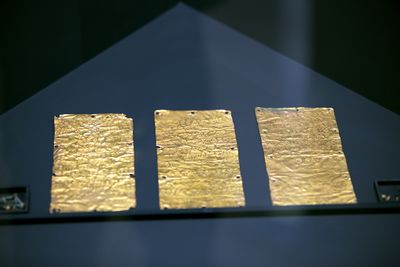
FAIR is a non-profit organization dedicated to providing well-documented answers to criticisms of the doctrine, practice, and history of The Church of Jesus Christ of Latter-day Saints.
When it first appeared, the Book of Mormon was attacked for the alleged absurdity of having been written on golden plates and its claim of the existence of an early sixth century B.C. version of the Hebrew Bible written on brass plates. Today, however, there are numerous examples of ancient writing on metal plates. Ironically, some now claim instead that knowledge of such plates was readily available in Joseph Smith's day. Hugh Nibley's 1952 observation seems quite prescient: "it will not be long before men forget that in Joseph Smith's day the prophet was mocked and derided for his description of the plates more than anything else." [1]

Recent reevaluation of the evidence now points to the fact that the Book of Mormon's description of sacred records written on bronze plates fits quite nicely in the cultural milieu of the ancient eastern Mediterranean.
One of the earliest known surviving examples of writing on "copper plates" are the Byblos Syllabic inscriptions (eighteenth century B.C.), from the city of Byblos on the Phoenician coast. The script is described as a "syllabary [which] is clearly inspired by the Egyptian hieroglyphic system, and in fact is the most important link known between the hieroglyphs and the Canaanite alphabet."[2]
It would not be unreasonable to describe the Byblos Syllabic texts as eighteenth century B.C. Semitic "bronze plates" written in "reformed Egyptian characters."[3]
Walter Burkert, in his study of the cultural dependence of Greek civilization on the ancient Near East, refers to the transmission of the practice of writing on bronze plates (Semitic root dlt) from the Phoenicians to the Greeks. "The reference to 'bronze deltoi [plates, from dlt ]' as a term [among the Greeks] for ancient sacral laws would point back to the seventh or sixth century [B.C.]" as the period in which the terminology and the practice of writing on bronze plates was transmitted from the Phoenicians to the Greeks.[4]
Students of the Book of Mormon will note that this is precisely the time and place in which the Book of Mormon claims that there existed similar bronze plates which contained the "ancient sacred laws" of the Hebrews, the close cultural cousins of the Phoenicians.
Burkert also maintains that "the practice of the subscriptio in particular connects the layout of later Greek books with cuneiform practice, the indication of the name of the writer/author and the title of the book right at the end, after the last line of the text; this is a detailed and exclusive correspondence which proves that Greek literary practice is ultimately dependent upon Mesopotamia. It is necessary to postulate that Aramaic leather scrolls formed the connecting link."[5]
Joseph Smith wrote that "the title page of the Book of Mormon is a literal translation, taken from the very last leaf, on the left hand side of the collection or book of plates, which contained the record which has been translated."[6]
This idea would have been counterintuitive in the early nineteenth century when "Title Pages" appeared at the beginning, not the end, of books.
Why, then, did Joseph claim the Book of Mormon practiced subscriptio—writing the name of the author and title at the end of the book? If the existence of the practice of subscriptio among the Greeks represents "a detailed and exclusive correspondence which proves that Greek literary practice is ultimately dependent upon Mesopotamia [via Syria]," as Burkert claims, cannot the same thing be said of the Book of Mormon—that the practice of subscriptio represents "a detailed and exclusive correspondence" which offers proof that the Book of Mormon is "ultimately dependent" on the ancient Near East?

FAIR is a non-profit organization dedicated to providing well-documented answers to criticisms of the doctrine, practice, and history of The Church of Jesus Christ of Latter-day Saints.
We are a volunteer organization. We invite you to give back.
Donate Now